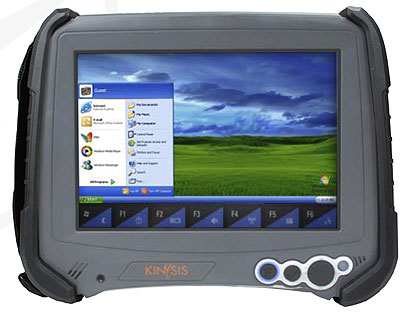Update 12/13/2010: Originally launched as the DAP Kinysis 8900VS, the unit is is now named M8910, bringing it in line with DAP's "Mxxxx" nomenclature for its lineup of handheld computers
In the summer of 2009, DAP Technologies launched the Kinysis family of lightweight, rugged tablet computers, later renamed the M8910 and M8920. The big news is that these are the first DAP products that run Windows Embedded Standard instead of Windows CE. There are two basic form factors, one with a full screen (the Kinysis 8900VS shown here), and one with a half screen and a keyboard. The Kinysis models use the same bodies and design as DAP's 8800 and 8640 CE-based tablets.

The Kinysis computers are powered by a AMD Geode LX800 processor running at 500MHz. This is a very power-efficient x86 processor perfectly capable of providing targeted performance in a Windows Embedded Standard environment and with modest hardware resources. The Kinysis models have up to 512MB of RAM, and use solid state disks up to 32GB. The 8900VS has a 7-inch TFT transmissive LCD with wide-format 800 x 480 resolution. The display is complemented by a series of dedicated function key/areas along the bottom.
Overall, the Kinysis offers "full" Windows capabilities and the great flexibility of Windows XP Embedded to DAP customers and others in search of a ultra-rugged tablet. Almost identical in size and weight to the keyboard-equipped Kinysis 8900KS, the 8900VS is a traditional slate for those who prefer a full WVGA display display to the 640x240 half-VGA that shares the 8900KS's frontside with the keyboard. The transmissive TFT color display is bright enough (450 nits) for graphics intensive work inside and out.
Like all DAP handhelds, the Kinysis is ultra-rugged and highly configurable via its sealed expansion bay that can accommodate various ports, modules and interfaces. You can also order the device with an optional Universal Imager with 3MP camera with auto-focus and flash, 1D/2D barcode reader, OCR and video capture.
While the world at large generally concentrates on Microsoft's desktop/notebook operating systems and the various Windows Mobile variants, Windows XP Embedded remains an excellent solution for vertical market devices. Unlike Windows 7, Vista or XP Pro, Windows Embedded Standard is not a shrinkwrapped one-size-fits all OS. Systems integrators can determine what a machine should be able to do and then include just the software blocks and components they need (hence the term "componentized" operating system). There are over 10,000 components to pick and choose from, and it's easy for experienced integrators to create lean, nimble embedded OS platforms that can still do sophisticated high level functions like advanced multimedia, browsing, communications or whatever a task requires. What it amounts to is that a Windows Embedded build provides all the power of the Windows XP engine, but without any unneeded overhead. In addition, Microsoft has now released the Windows 7-based Windows Embedded Standard 2011 (formerly code-named "Quebec") Community Technology Preview for OEMs and developer, and this opens a path towards the next version of Windows Embedded.
With the M8900 Series, DAP Technologies brings Windows Embedded power and flexibility in two eminently practical form factors based on rugged, field-proven designs.



